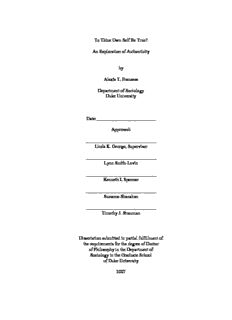
To Thine Own Self Be True? An Exploration of Authenticity by Alexis T. Franzese Department of ... PDF
Preview To Thine Own Self Be True? An Exploration of Authenticity by Alexis T. Franzese Department of ...
To Thine Own Self Be True? An Exploration of Authenticity by Alexis T. Franzese Department of Sociology Duke University Date:__________________________ Approved: _______________________________ Linda K. George, Supervisor _______________________________ Lynn Smith-Lovin _______________________________ Kenneth I. Spenner _______________________________ Suzanne Shanahan _______________________________ Timothy J. Strauman Dissertation submitted in partial fulfillment of the requirements for the degree of Doctor of Philosophy in the Department of Sociology in the Graduate School of Duke University 2007 ABSTRACT To Thine Own Self Be True? An Exploration of Authenticity by Alexis T. Franzese Department of Sociology Duke University Date:__________________________ Approved: _______________________________ Linda K. George, Supervisor _______________________________ Lynn Smith-Lovin _______________________________ Kenneth I. Spenner _______________________________ Suzanne Shanahan _______________________________ Timothy J. Strauman An abstract of a dissertation submitted in partial fulfillment of the requirements for the degree of Doctor of Philosophy in the Department of Sociology in the Graduate School of Duke University 2007 Copyright by Alexis T. Franzese 2007 ABSTRACT To Thine Own Self Be True? An Exploration of Authenticity What does it mean to be authentic? Is authenticity an attribute of the individual, or do certain environmental factors facilitate or inhibit the enactment of the authentic self? This research proposes that authentic behavior is the subjective perception that one is behaving in a way that is in accordance with his or her core being. As such, sense of authenticity is considered an important component of the self. I present a theoretical model of the relationship between authenticity and the need for social approval. I analyze the reports of 194 survey respondents and interview data from 21 interviews. These quantitative and qualitative analyses suggest that individuals engage in authentic and inauthentic behavior for a variety of reasons. Specifically, three different behavioral motivations have been identified: (1) behavior motivated by pursuit of the greater social good or for purposes of social cohesion, (2) behavior motivated by pursuit of instrumental gains, and (3) behavior motivated by an internal standard of integrity. Demographic variables and psychological variables were also found to be important determinants of authentic behavior. Blacks reported lower need for social approval than whites, and subsequently higher reports of authentic behavior. Self-esteem emerged in the analyses as a powerful predictor of authentic behavior. In tandem, these results suggest that it may not be one’s level of social power that determines his or her ability to behave in ways deemed authentic, but rather one’s sense of freedom and confidence in oneself. iv Table of Contents Abstract.......................................................................................................................iv List of Tables.............................................................................................................viii List of Figures...............................................................................................................x Acknowledgements and Dedication............................................................................xi 1. Introduction...............................................................................................................1 1.1 Background and Significance..............................................................................5 2. Theoretical Foundations..........................................................................................11 2.1 Philosophical Foundations................................................................................11 2.2 Psychological Foundations................................................................................18 2.3 Sociological Foundations..................................................................................29 2.4 The ‘True’ Self..................................................................................................47 2.5 Challenges to Traditional Theories (Modernity and Post-Modernism)............51 2.6 Philosophical, Psychological and Sociological Implications for a Theory of Authenticity.............................................................................................................55 3. Review of Relevant Literature................................................................................56 3.1 Psychological Roots: Empirical Work..............................................................56 3.2 Sociological Roots: Empirical Work.................................................................71 4. Conceptual Model and Supporting Literature.........................................................81 4.1 Exploration of Authenticity and Association with Structural Factors..............81 4.2 Authenticity and Social Approval.....................................................................82 4.3 The Need for Social Approval..........................................................................83 4.4 Models...............................................................................................................83 v 4.5 Social Stratification as Determinant..................................................................86 4.6 Formal Hypotheses............................................................................................87 4.7 Issues Addressed with Qualitative Data..........................................................108 4.8 Contributions...................................................................................................108 5. Design and Methods..............................................................................................110 5.1 Sample.............................................................................................................111 5.2 Measures..........................................................................................................117 5.3 Descriptive Statistics.......................................................................................125 5.4 Methods of Analysis........................................................................................131 6. Quantitative Results..............................................................................................135 6.1 Quantitative Assessment of Formal Hypotheses.............................................135 6.2 Need for Social Approval and Authentic Behavior Summary Scales.............142 6.3 Other Considerations.......................................................................................147 6.4 Authenticity Subscales....................................................................................150 6.5 Interactions......................................................................................................157 6.6 Post-Hoc Analyses..........................................................................................160 6.7 Overall Patterns...............................................................................................172 7. Qualitative Results................................................................................................178 7.1 Analysis of Qualitative Data...........................................................................178 7.2 Themes............................................................................................................253 8. Discussion and Conclusions..................................................................................260 8.1 Overall Trends.................................................................................................261 vi 8.2 Trends of Post-Hoc Analyses..........................................................................275 8.3 Implications of this Research..........................................................................278 8.4 Limitations......................................................................................................281 8.5 Future Research and Concluding Remarks.....................................................283 Appendices................................................................................................................289 Appendix A: Demographic Questionnaire...........................................................289 Appendix B: Authenticity Inventory.....................................................................296 Appendix C: NSA Instrument...............................................................................298 Appendix D: Awareness Scale..............................................................................299 Appendix E: Rosenberg Self-Esteem Scale..........................................................300 References.................................................................................................................301 Biography..................................................................................................................320 vii List of Tables Table 5.1 Power Estimates for Proposed Regression Models...................................113 Table 5.2 Interview Sample (N=21)..........................................................................116 Table 5.3 Measurement of Questionnaire Data.........................................................121 Table 5.4 Descriptive Statistics for Study Participants (N=194)..............................128 Table 5.5 Description of Study Participants According to Ethnicity, Age, and Gender, (N=194).....................................................................................................................129 Table 5.6 Descriptive Statistics for Interview Participants (N=21)..........................130 Table 6.1 Control, Predictor, and Outcome Variables: Correlations (N=194)..........138 Table 6.2 Correlations between Authenticity Subscales and NSA (N=194)............141 Table 6.3 Unstandardized Regression Coefficients for Predicting Need for Social Approval (N=194) ....................................................................................................143 Table 6.4 Unstandardized Regression Coefficients for Predicting Authentic Behavior (N=194).....................................................................................................................146 Table 6.5 Unstandardized Regression Coefficients for Predicting Congeniality Subscale Scores (N=194)..........................................................................................152 Table 6.6 Unstandardized Regression Coefficients for Predicting Self-Gain Subscale Scores (N=194).........................................................................................................154 Table 6.7 Unstandardized Regression Coefficients for Predicting Integrity Subscale Scores (N=194)..........................................................................................................156 Table 6.8 Unstandardized Regression Coefficients for Retirement Status Predicting Authentic Behavior (N=193) ....................................................................................163 Table 6.9 Unstandardized Regression Coefficients for Religious Participation Predicting Need for Social Approval (N=192)..........................................................167 Table 6.10 Unstandardized Regression Coefficients for Religious Participation Predicting Authentic Behavior (N=192)...................................................................168 viii Table 6.11 Unstandardized Regression Coefficients for Religious Participation Predicting Congeniality Subscale Scores (N=192)...................................................169 Table 6.12 Unstandardized Regression Coefficients for Religious Participation Predicting Integrity Subscale Scores (N=192)..........................................................170 Table 6.13, Summary of Findings (N=194)..............................................................177 ix List of Figures Figure 4.1 Need for Social Approval and Behavior...................................................84 Figure 4.2 Structural Determinants of Need for Social Approval and Authentic Behavior......................................................................................................................85 Figure 8.1 Determinants of Authentic Behavior.......................................................276 x
Description: